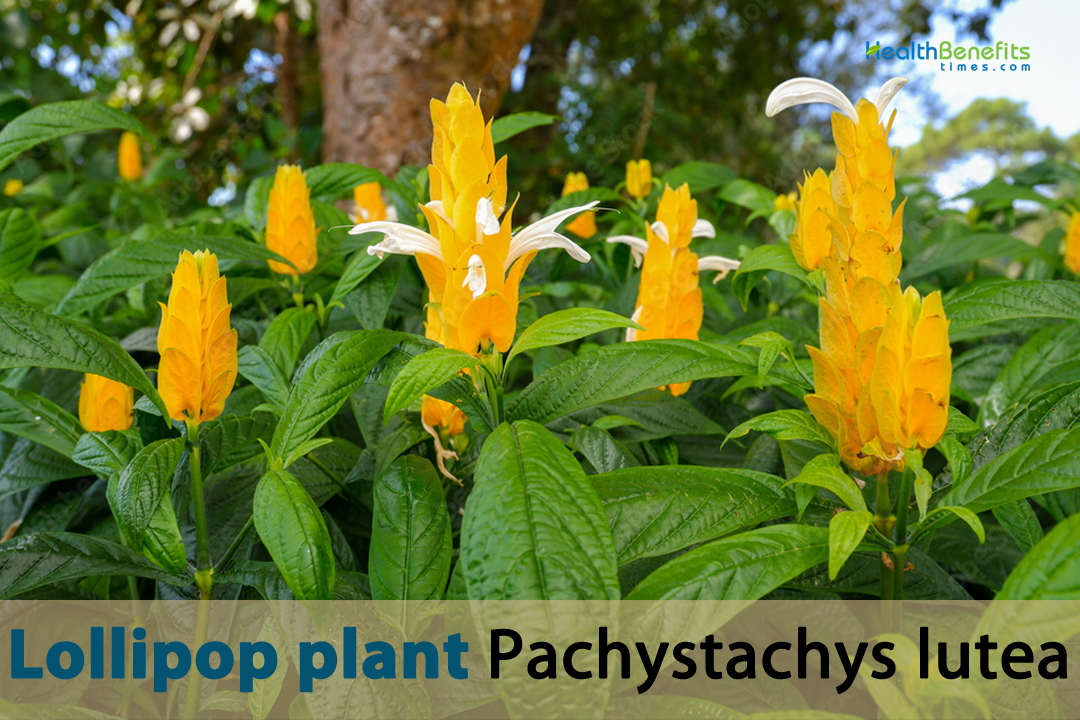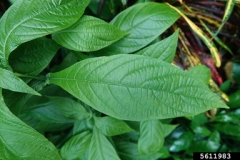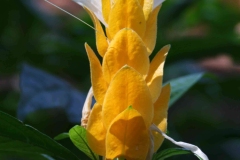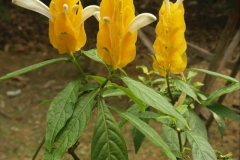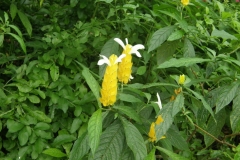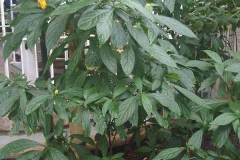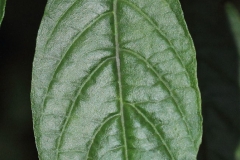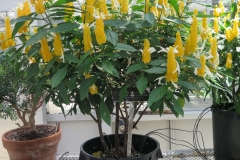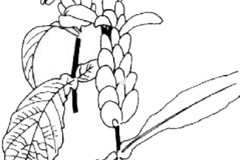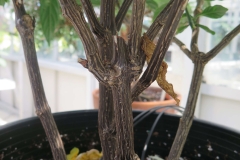| Lollipop plant Quick Facts | |
|---|---|
| Name: | Lollipop plant |
| Scientific Name: | Pachystachys lutea |
| Origin | Tropical regions of Peru and other parts of Central and South America, particularly regions with a tropical climate like Costa Rica, Panama, and Colombia |
| Shapes | Capsules |
| Major nutrients | • Nitrogen • Phosphorus • Potassium • Calcium • Magnesium • Sulfur • Iron • Manganese • Zinc • Copper |
| Health benefits | Treat fever, coughs, colds, hair loss and pneumonia |
| Name | Lollipop plant |
|---|---|
| Scientific Name | Pachystachys lutea |
| Native | Tropical regions of Peru and other parts of Central and South America, particularly regions with a tropical climate like Costa Rica, Panama, and Colombia. |
| Common Names | Golden shrimp-plant, Golden-candle, Lollipop-plant, Yellow shrimp-plant, Yellow-candles, golden yellow lollipop plant, Lollipop Flower, Golden Candle Plant |
| Name in Other Languages | Afrikaans: Gouekers Arabic: Nabāt al-lūlībūb (نبات اللوليبوب), Nabāt al-jambarī al-dhahabī (نبات الجمبري الذهبي) Assamese: Hunboronia Brazil: Camarao Bulgarian: Zhŭlt pakhistakhis (жълт пахистахис) Chinese: Jīn bāo huā (金苞花), Huáng xiā huā (黃蝦花), Bàngbàngtáng zhíwù (棒棒糖植物), Jīn xiā zhíwù (金虾植物) Czech: Tlustoklasec žlutý, Lízátko Rostlina, Zlatá Kreveta Danish: Slikkepind Plante, Gylden Reje Plante Dutch: Gele garnalenplant, Lolly Plant, Gouden Garnaal Plant English: Golden shrimp-plant, Golden-candle, Lollipop-plant, Yellow shrimp-plant, Yellow-candles, golden yellow lollipop plant, Filipino: Halaman ng Lollipop, Halaman ng Hipon Ginto Finnish: Keltakultakäpy, lollypops, Tikkukaramelli Kasvi, Kultainen Katkarapu Kasvi French: Chandelle, pachystachys jaune, panache d’officier, plume d’officier, Plante Crevette Dorée German: Gelbe Dickähre, Gelber Zimmerhopfen, Goldähre, Kurzähre, Lutscher Pflanze, Goldgarnele Pflanze Greek: Fyto Glefitzouri (Φυτό Γλειφιτζούρι), Chrysi Garida Fyto (Χρυσή Γαρίδα Φυτό) Hindi: Lollipop Plant (लॉलीपॉप प्लांट), Sone ki Jhinga Plant (सोने की झींगा प्लांट) Hungarian: Nyalóka Növény, Arany Garnéla Növény Icelandic: Lollípopp Planta, Gullin Rækja Planta Indonesian: Tanaman Lolipop, Tanaman Udang Emas Italian: Pianta Lecca-lecca, Pianta Gambero Dorato Japanese: Pakisutakisu (パキスタキス), Roripoppupuranto (ロリポッププラント), Gōruden shurinpu puranto (ゴールデンシュリンププラント) Javanese: Kembang lilin Korean: Rolripab sikmul (롤리팝 식물), Goldeun saeu sikmul (골든 새우 식물) Malay: Pokok Lolipop, Pokok Udang Emas Maya: Camaron amarillo Norwegian: Sugepinne Plante, Gullreke Plante Persian: پاچیستاچیس Polish: Roślina Lizak, Złota Krewetka Portuguese: Planta Pirulito, Camarão Dourado Romanian: Planta Lollipop, Planta Creveți Aurii Russian: Pakhistakhis zholtyy (Пахистахис жёлтый), Ledentsovoye Rasteniye (Леденцовое Растение), Zolotaya Krevetka (Золотая Креветка) Slovak: Lízatko Rastlina, Zlatá Kreveta Rastlina Spanish: Chocolo de oro, Camarón Amarillo Swedish: Guldax, Klubba Växt, Gyllene Räka Växt Thai: H̄elụ̄xng khīrībūn (เหลืองคีรีบูน), Phụ̄ch lūkxm (พืชลูกอม), Phụ̄ch k̄hụ̄ng thxng (พืชกุ้งทอง) Tongan: ʻAkauʻuoiiki enga Turkish: Lolipop Çiçeği, Altın Karides Bitkisi Vietnamese: Long thủ vàng, Cây Kẹo Lollipop, Cây Tôm Vàng |
| Plant Growth Habit | Colorful, tropical, soft-stemmed perennial evergreen shrub |
| Growing Climates | Tropical rainforests, subtropical gardens, greenhouses and conservatories, indoor environments, botanical gardens and arboretums, tropical resorts and parks |
| Soil | Well-draining, loamy soil enriched with organic matter is ideal for the lollipop plant. It appreciates regular watering to maintain evenly moist soil, but take care not to overwater, as excessive moisture can lead to root rot |
| Plant Size | About 2 feet indoors and up to 4 feet tall outdoors and 2 – 3ft wide |
| Stem | Stems are much branched or clumping, erect, base gradually lignified. It is not particularly showy |
| Leaf | Opposite, dark green, narrow ovate up to 12 centimeters long with distinct veins, glossy folds and entire margin undulate |
| Flowering season | May, June, July, August, September, October |
| Pollinators |
|
| Flower | Flowers are in a large terminal spike, up to 10 centimeters long, with large, golden yellow cordate bracts. Corolla is white |
| Fruit Shape & Size | Fruit is a capsule |
| Plant Parts Used | Root, leaves and flower |
| Propagation |
|
| Varieties |
|
| Major Nutrition |
|
| Traditional Uses |
|
Plant Description
The vibrant, evergreen, tropical lollipop plant is a perennial with soft-stemmed leaves that typically reaches heights of 2 feet indoors and 4 feet outdoors, with a width of 2 to 3 feet. Occasional pruning may be necessary to preserve its form. However, it tends to remain smaller when grown in containers or as houseplants, which makes it an excellent option for limited spaces. Tropical resorts and parks, subtropical gardens, greenhouses and conservatories, botanical gardens and arboretums, and tropical rainforests are all habitats for this plant. For the lollipop plant, well-draining loamy soil that has been fortified with organic matter is optimal. Consistent irrigation is essential for maintaining uniform soil moisture levels; however, be cautious not to overwater, as an excess of moisture may result in root rot. Maintain a consistently moist, but not saturated, soil. Too-alkaline soil should be avoided, as it can induce leaf discoloration.
As an ornamental plant, the Lollipop Plant is frequently incorporated into landscapes and gardens due to its striking appearance. It has the capacity to flourish in containers, borders, or even when left unattended. Furthermore, its ability to entice hummingbirds and butterflies increases its desirability among gardeners who wish to promote wildlife. Probably as a result of its vivid and upbeat appearance, the Lollipop Plant is regarded as a symbol of joy and tenderness in some cultures. Occasionally, it is presented as a gift within these particular contexts. Although the Lollipop Plant exhibits a generally resilient nature, it can become vulnerable to prevalent pests such as mealy bugs, aphids, and spider mites, particularly when cultivated indoors or under conditions that deviate from its natural environment. With routine inspections and timely treatment, these pests can be kept at bay.
Stem
The erect, heavily branched or clumping stems have a progressively lignified base. It is not notably spectacular.
Leaf
Up to 12 centimeters in length, the leaves are opposite, glossy, dark green, narrow ovate, and feature distinct veins, glossy pleats, and an undulating entire margin. These lance-shaped leaves serve as a verdant backdrop for the vibrant inflorescence of the plant.
Flower
Inflorescence is composed of a spike that is enveloped in bracts that are yellow-golden in color. The shape of the pure white flowers is tubular and slender. The four-sided inflorescence is composed of dazzling, overlapping yellow bracts that partially envelop each individual flower. As the common name suggests, the yellow bracts resemble the overlapping scales of a crustacean.
Growing and Caring Tips for Lollipop Plant
Light
Lollipop Plant thrives in indirect, strong sunlight. Nevertheless, it can endure partial shade as well. Maintaining the plant indoors in close proximity to a window that receives sufficient sunlight is essential. Alternatively, you must position these plants to receive morning sun and afternoon shade if you choose to cultivate them outdoors.
Watering
Candy lollipop Constant moisture is required for plants, but not saturation. When you feel that the top inch of soil is dried, water the plant. Avoid overwatering the plant, as doing so could result in root decay. Additionally, be certain to store it in a container with excellent drainage.
Soil
Soil that is slightly acidic and well-draining is ideal for lollipop plants. Equal parts perlite, peat moss, and vermiculite should be combined with respectable, well-draining potting soil. A soil that is excessively alkaline may cause the foliage to turn yellow.
Temperature
Lollipop Plants require year-round temperatures ranging from 60 to 80 degrees Fahrenheit. The plant is tolerant of a marginally reduced nighttime temperature. Nevertheless, it is imperative that you refrain from exposing the plant to temperatures that fall below 50 degrees Fahrenheit.
Humidity
Lollipop Plants flourish in environments with high humidity. Consequently, they should be misted frequently and placed in a pebble tray full with water. Alternatively, one may employ a humidifier to augment the relative humidity in the vicinity of the plant.
Fertilizing
Apply a balanced, water-soluble fertilizer to your burgeoning lollipop plant every 14 to 15 days. This will stimulate robust development and an abundance of blossoms. Adhere to the dosage instructions provided on the packaging when utilizing the plant.
Re-Potting
Each year in the spring, the Lollipop Plant can be re-potted. If not feasible, the plant should be re-potted once its roots emerge from the drainage holes in the pot.
Propagation
Straw cuttings can be utilized to propagate Lollipop Plants with relative ease during the spring and summer seasons. Before placing the stems in potting soil, cut them to a length of four inches and submerge them in a decaying hormone.
Pruning and Grooming
Due to its rapid growth, this plant must be pruned in the spring in order to maintain a manageable size indoors. Remove them from the area immediately above the leaf node where the leaves meet the vapor. As soon as you observe a dying blossom head, prune it as well. This phenomenon stimulates the plant’s growth. Additionally, prune the Lollipop Plant by removing the uppermost portion of its primary stem, which will allow it to flourish in a compact form. This will render it entirely comprehensive and attractive when viewed indoors.
Lollipop Plant Varieties
- Madagascar Palm (Pachypodium lamerei): The Madagascar Palm, distinguished by its thick, bottle-shaped trunk and prickly leaves, infuses an air of exoticism into any collection. This variety, which is indigenous to Madagascar, flourishes in well-draining soil and favors ample sunlight.
- Pachypodium Succulent (Pachypodium succulentum): The Pachypodium succulent, which share a bottle-shaped trunk and glossy, green foliage, is an endearing diminutive relative of the Madagascar Palm. This South African variety is highly adaptable for cultivation in both indoor and outdoor environments.
- Nong Nooch Palm (Pachypodium rosulatum): The Nong Nooch Palm, a magnificent lollipop plant with an appealing foliage and a more compact growth habit, is native to Thailand. Its leaf rosette contributes an aesthetic touch to both indoor and outdoor spaces.
- Pachypodium Geayi: Pachypodium Geayi is a larger variety of lollipop plant indigenous to Madagascar, distinguished by its towering stature and visually captivating appearance. Its distinctive growth pattern and spiny foliage render it an enthralling focal point for any garden.
- Pachypodium Horombense: An additional Madagascar delicacy, Pachypodium Horombense is an uncommon and coveted variety of lollipop plant. Due to its appealing foliage and distinctive growth pattern, it is highly valued in collectors’ gardens.
- Pachypodium Lamerei Hybrid: Hybridized lollipop plants are the result of combining the most advantageous characteristics of numerous Pachypodium species. There may be variations in color, size, and growth pattern among hybrid varieties.
- Pachypodium Brevicaule: The intriguing Pachypodium Brevicaule lollipop plant variety is distinguished by its diminutive stature and unique caudex. It is indigenous to Madagascar and flourishes in arid environments with well-draining soil.
Health benefit
Lollipop plants contribute to the aesthetic appeal of an indoor or outdoor space in more ways than one. Additionally, they provide an array of advantages that positively impact both your health and the environment. Let us examine the manifold benefits that accompany the presence of these delightful flora in one’s life:
1. Air Purification Properties
Air pollutants are effectively filtered out by lollipop plants, thereby enhancing indoor air quality. By absorbing toxins and emitting oxygen, the foliage of these plants promote a healthier living environment.
2. Stress-Relieving Effects
There is evidence that the presence of lollipop plants can alleviate tension and enhance mental health. Horticultural therapy, or the practice of tending to plants, can be a therapeutic and soothing activity.
3. Low Maintenance Requirements
Due to their generally minimal maintenance requirements, lollipop plants are appropriate for both novice and experienced gardeners. They can flourish in a variety of environments, including indoor spaces with limited sunlight, given the appropriate maintenance.
4. Educational Opportunities
Particularly for children, lollipop plant cultivation offers invaluable educational opportunities. An interest in the cultivation, propagation, and maintenance of plants inspires both accountability and inquisitiveness.
5. Symbolism and Cultural Significance
Cultural significance is attributed to lollipop plants in numerous traditions and folklore. They are frequently correlated with favorable emblems, including protection, good fortune, and fortitude.
6. Contribution to Sustainable Living
Lollipop plants can be incorporated into an eco-friendly and sustainable lifestyle. Engaging in responsible sourcing and care practices positively impacts the environment as a whole.
Pests and diseases
- Aphids, mites and whiteflies: These insects extract the moisture from foliage, resulting in leaf damage and deformed development. To address this concern, one may employ horticultural lubricants, insecticidal soaps, beneficial predators, or water sprays to dislodge the pests.
- Scale insects: These pests feed on the plant’s juices and manifest as small bumps on the stems and foliage. Manual removal or the administration of insecticidal soaps and horticultural oils may be employed to mitigate their effects.
- Caterpillars: Caterpillars are enormous, conspicuous pests that can inflict significant damage upon plant life. In most cases, they are removable manually via handpicking. If not, consider eliminating them with a chemical insecticide.
- Fungal diseases: Leaf spot and powdery mildew are extremely prevalent diseases. To prevent these, ensure adequate interplant spacing to promote air circulation, apply fungicide treatment, and prune away the affected regions.
- Root rot: When lollipop plants are overwatered, fungi flourish in the ideal conditions created at their roots. To prevent this, ensure adequate soil drainage and refrain from overwatering the plants.
- Bacterial infections: Bacterial infestation may result in leaf cankers, withering, and leaf spots. These issues can be mitigated through the administration of copper-based fungicides, proper sanitation, and the prompt removal of affected areas.
Different Uses
- Ornamental Use: As an ornamental plant, the Lollipop plant is most frequently utilized. Popular as a houseplant, in gardens, and on patios, it is distinguished by its brilliant yellow blossoms and verdant foliage. It has the ability to impart a tropical ambiance to any environment.
- Landscaping: As a specimen plant, in tropical and subtropical regions, the Lollipop plant can be utilized in mass arrangements, as well as in landscaping for borders. In gardens, its arresting appearance can serve as a focal point.
- Indoor Air Purification: The Lollipop plant, similar to numerous other houseplants, has the potential to enhance indoor air quality. By absorbing pollutants and emitting oxygen, vegetation can improve the indoor environment.
- Butterfly and Hummingbird Attraction: As a result of its ability to entice hummingbirds and butterflies, the Lollipop plant is an advantageous addition to garden biodiversity and a supporter of pollinator populations.
- Educational Use: The Lollipop plant can be utilized to educate in academic environments, including botanical gardens and schools, regarding plant biology, pollination, and the ecology of tropical plants.
- Cut Flowers: While not as prevalent as alternative applications, the distinctive blossoms of the Lollipop plant can be utilized to impart a tropical ambiance to bouquets or as cut flowers.
- Medicinal and Herbal Uses: Although information regarding the particular medicinal applications of the Lollipop plant is limited, numerous plants native to tropical regions are utilized in traditional medicine. It is essential to note, however, that Pachystachys lutea has no widely recognized medicinal application, and its use for health-related purposes should be avoided in the absence of scientific evidence or the advice of a healthcare professional.
References:
https://www.cabidigitallibrary.org/doi/10.1079/cabicompendium.38497
https://www.missouribotanicalgarden.org/PlantFinder/PlantFinderDetails.aspx?taxonid=275296
https://gd.eppo.int/taxon/PAHLU
http://www.stuartxchange.com/GoldenCandle
https://en.wikipedia.org/wiki/Pachystachys_lutea
https://indiabiodiversity.org/species/show/230560
https://www.flowersofindia.net/catalog/slides/Golden%20Shrimp%20Plant.html
https://plants.usda.gov/home/plantProfile?symbol=PALU7


